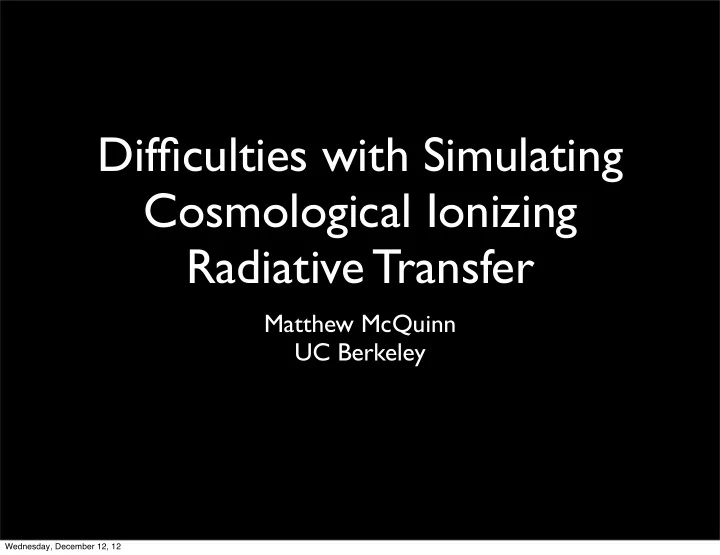

Difficulties with Simulating Cosmological Ionizing Radiative Transfer Matthew McQuinn UC Berkeley Wednesday, December 12, 12
Outline • the impact of Lyman-limit systems on reionization • towards better source models ★ the impact of photoionization feedback Wednesday, December 12, 12
Γ The importance of Lyman-limit systems (LLSs) After Reionization During Reionization 1 0 0 c o m o v i n g M p c Are they capturing this transition? Mean free path limited by Mean free path limited by dense systems w/ δ =10-1000 bubbles S Observed i m u l a t i o n s 2 4 6 8 Redshift Intensity of Ionizing Background = (mean free path) x (source emissivity) Wednesday, December 12, 12
Capturing LLSs is crucial for understanding z=6 Hydrogen Ly α forest Neutral region: ◆ 3 / 2 ✓ 1 + z τ GP = 3 × 10 5 x HI (1 + δ ) 7 Photoionized region: ✓ 10 − 12 s − 1 ◆ 9 / 2 ◆ ✓ 1 + z τ GP = 9 (1 + δ ) 2 7 Γ HI x u l F d e z τ eff i GP ⌘ � log h F i l a m r o N Difficult to explain fast evolution with reionization because occurs in 0.1 H(z) -1 Wednesday, December 12, 12
Other reason: could change structure of reionization Choudhury et al (2009) McQuinn et al 2007 (see also Furlanetto & Oh ’05) Wednesday, December 12, 12
Project: Study Lyman-limit systems (dense self-shielding systems) Goal: Understand properties at end and after reionization Do this for a few tens of thousands of groups. Wednesday, December 12, 12
What self-shielding systems look like (z=4) 0.5 Mpc N HI Wednesday, December 12, 12
Comparison w/ Observations at z=4 Highlighted regions HI Column density distribution are observational constraints derived/ compiled in Prochaska, Omeara, Worseck (2010) Most important for mean free path. McQuinn, Oh, Faucher-giguere, ’11 (also see Altay et al ’11) Simulations able to (approximately) reproduce gas at outskirts of galactic halos. They should do better with increasing redshift. Wednesday, December 12, 12
Comparison w/ Observations at z=4 Very Steep Highlighted regions β ≥ 1.7 HI Column density distribution are observational constraints derived/ compiled in Prochaska, Omeara, Worseck (2010) Most important for mean free path. McQuinn, Oh, Faucher-giguere, ’11 (also see Altay et al ’11) Simulations able to (approximately) reproduce gas at outskirts of galactic halos. They should do better with increasing redshift. Wednesday, December 12, 12
Intensity = (mean free path) x (source emissivity) Wednesday, December 12, 12
Intensity = (mean free path) x (source emissivity) Measured from Ly α Forest Wednesday, December 12, 12
Distance between dense self-shielding systems Intensity = (mean free path) x (source emissivity) Measured from Ly α Forest Wednesday, December 12, 12
# of Recombinations Distance between (clumpiness of dense dense self-shielding systems) systems Intensity = (mean free path) x (source emissivity) Measured from Ly α Forest Wednesday, December 12, 12
# of Recombinations Distance between (clumpiness of dense dense self-shielding systems) systems Intensity = (mean free path) x (source emissivity) ≈ emissivity 1/(2 - β ) (assumes power-law profile for systems) Measured from Ly α Forest Wednesday, December 12, 12
# of Recombinations Distance between (clumpiness of dense dense self-shielding systems) systems Intensity = (mean free path) x (source emissivity) ≈ emissivity 1/(2 - β ) (assumes power-law profile for systems) At z=4, simulations predict a 10% change in Measured emissivity can result in 30% change in Γ . from Ly α At z=6, simulations predict a 10% change in Forest emissivity can result in factor of 2 change in Γ . Possible explanation for evolution seen in Fan et al (2006). Strong scaling related to result that IGM clumping factor <(1 + δ ) 2 > is << 10 (e.g., Pawlik et al ’08) Wednesday, December 12, 12
Implications for reionization simulations • ionizing background and Lyman-limit systems strongly coupled • we aren’t making it any easier on ourselves by having sources that are too emissive! • You cannot barely resolve these systems to capture their impact. The mfp is also not just one number during reionization. LL density: LL size: Above numbers are from model of Schaye ’01 Wednesday, December 12, 12
Temperature dashed and solid curves are at 10 and 100 Myr respectively (McQuinn ’12) Wednesday, December 12, 12
Conclusions • Simulations need to capture Lyman-limit systems! • There is an intuitive picture that describes the halo masses that can accrete gas after reionization. Wednesday, December 12, 12
Recommend
More recommend